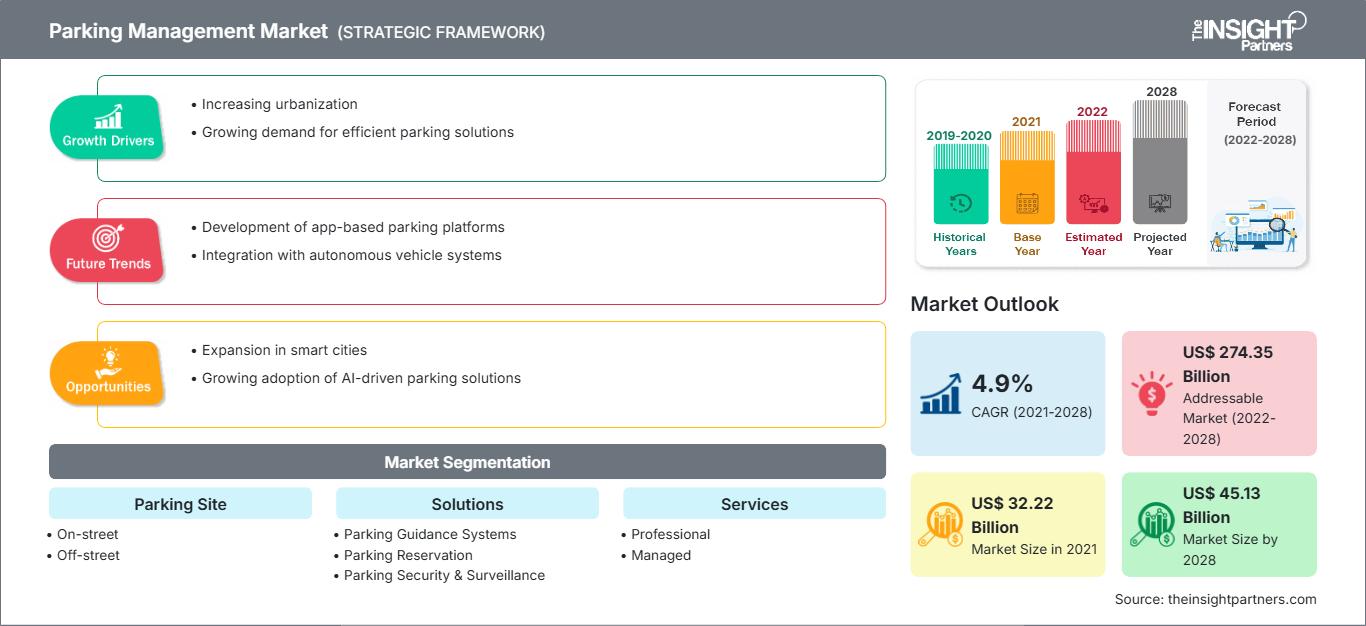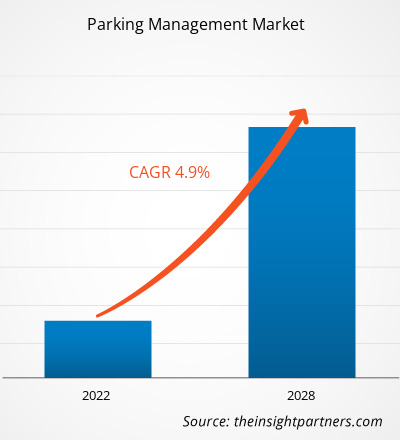Si prevede che il mercato della gestione dei parcheggi crescerà da 32.221,73 milioni di dollari nel 2021 a 45.125,82 milioni di dollari entro il 2028; si stima una crescita a un CAGR del 4,9% nel periodo 2021-2028.
Le principali città di diversi paesi in tutto il mondo stanno adottando massicciamente tecnologie intelligenti con l'obiettivo di ridurre il traffico quotidiano e le difficoltà di parcheggio. Traffico e parcheggi sono problemi di lunga data sia nelle regioni sviluppate che in quelle emergenti. Attualmente, le tecnologie di parcheggio intelligenti stanno rivoluzionando la gestione dei parcheggi e la domanda di tecnologie di parcheggio intelligenti è in crescita esponenziale. Le tecnologie intelligenti, che stanno registrando una crescita enorme nell'attuale sistema di gestione dei parcheggi, includono sistemi di guida informatica al parcheggio, parcheggi automatizzati, sistemi di pagamento intelligenti per i parcheggi e sistemi di prenotazione dei parcheggi. Oltre a queste tecnologie, anche la domanda di sicurezza e protezione dei veicoli parcheggiati sta aumentando rapidamente tra conducenti e proprietari di veicoli, il che sta spingendo l'acquisto di sistemi di videosorveglianza per i parcheggi, creando così un ampio spazio di mercato per la crescita delle società di gestione dei parcheggi nel corso degli anni.
Impatto della pandemia di COVID-19 sul mercato della gestione dei parcheggi
La pandemia di COVID-19 ha scosso diversi settori in tutto il mondo. Il lockdown ha ostacolato le attività di vari settori, tra cui quello manifatturiero e IT. Tuttavia, settori essenziali come quello dei beni di largo consumo (FMCG) e quello farmaceutico hanno dovuto continuare le loro attività. L'epidemia ha causato interruzioni in settori primari come l'elettronica, i semiconduttori e l'automotive. Un forte calo della crescita in questi settori sta limitando la crescita del mercato della gestione dei parcheggi. La chiusura delle fabbriche, i divieti di viaggio e di commercio e i blocchi alle frontiere per combattere e contenere l'infezione hanno avuto un impatto sul funzionamento di molti edifici commerciali e aziendali in tutto il mondo. Attualmente, gli Stati Uniti sono il paese più colpito al mondo dall'epidemia di COVID-19. La maggior parte degli enti pubblici e dei comuni dipendono dalle tasse e dai ricavi derivanti dai parcheggi per finanziare diversi grandi progetti per i cittadini del Paese. Edifici aziendali, centri commerciali, università, centri commerciali, ospedali, hotel, aeroporti e molti altri dispongono di ottime strutture e servizi di parcheggio per gestire in modo efficiente le loro attività. A causa dell'impatto della pandemia di COVID-19, delle attività trasversali e del mantenimento del distanziamento sociale per supportare il rallentamento della diffusione del virus, il settore dei parcheggi sta subendo un impatto molto duro. Molte aziende sono state sottoposte a enormi pressioni per sopravvivere e centinaia di migliaia di lavoratori in prima linea stanno perdendo il lavoro. Il monitoraggio in tempo reale delle dinamiche di oltre 2.000 parcheggi in tutto il Nord America, nonché le osservazioni per migliorare la comprensione quantitativa dell'impatto del COVID-19 sui parcheggi.
Personalizza questo rapporto in base alle tue esigenze
Potrai personalizzare gratuitamente qualsiasi rapporto, comprese parti di questo rapporto, o analisi a livello di paese, pacchetto dati Excel, oltre a usufruire di grandi offerte e sconti per start-up e università
Mercato della gestione dei parcheggi: Approfondimenti strategici

-
Ottieni le principali tendenze chiave del mercato di questo rapporto.Questo campione GRATUITO includerà l'analisi dei dati, che vanno dalle tendenze di mercato alle stime e alle previsioni.
Il mercato dei sistemi di gestione dei parcheggi a livello globale è altamente frammentato, poiché diversi operatori operano nel settore con le rispettive tecnologie e servizi. Ciò ha creato notevoli complessità tra gli utenti finali dei sistemi di gestione dei parcheggi. La necessità e la domanda di sistemi di gestione dei parcheggi tecnologicamente avanzati è in continuo aumento sia nelle regioni sviluppate che in quelle emergenti in tutto il mondo. Gli operatori del mercato della gestione dei parcheggi hanno una significativa opportunità di crescita nel prossimo futuro grazie alla partnership con altri fornitori di servizi di gestione dei parcheggi e con le amministrazioni pubbliche. Le partnership tra i fornitori di servizi facilitano l'offerta di servizi personalizzati che si prevede guideranno notevolmente il mercato. Ad esempio, a luglio 2021, Passport ha consentito il pagamento del parcheggio direttamente tramite il sistema di infotainment Uconnect nei veicoli Chrysler, Dodge, Jeep e Ram, grazie a una partnership con Xevo, leader nelle tecnologie per auto connesse e nelle esperienze utente innovative. Analogamente, nel 2020, T2 Systems, azienda specializzata in tecnologie per il parcheggio, ha collaborato con TEZ, i creatori di TEXT2PARK, per offrire T2 MobilePay, una soluzione di pagamento per il parcheggio tramite dispositivi mobili che offre agli utenti un metodo semplice e pratico per pagare il parcheggio tramite cellulare, consentendo agli operatori di gestire i propri dati e ricavi.
Approfondimenti di mercato basati sui parcheggi
In base ai parcheggi, il mercato globale della gestione dei parcheggi è segmentato in parcheggi su strada e parcheggi fuori strada. Nel 2020, il segmento dei parcheggi fuori strada ha dominato il segmento dei parcheggi e ha rappresentato una quota di mercato maggiore.
Approfondimenti di mercato basati sulle soluzioni
In base alle soluzioni, il mercato della gestione dei parcheggi è segmentato in soluzioni di assistenza al parcheggio, soluzioni di prenotazione del parcheggio, soluzioni di sicurezza e sorveglianza del parcheggio e altre ancora. Nel 2020, il segmento "Altri" ha guidato il mercato della gestione dei parcheggi e ha rappresentato la quota di mercato maggiore.
Approfondimenti di mercato basati sui servizi
In base ai servizi, il mercato della gestione dei parcheggi è segmentato in servizi gestiti e servizi professionali. Nel 2020, il segmento dei servizi gestiti ha guidato il mercato della gestione dei parcheggi e ha rappresentato una quota di mercato maggiore.
Approfondimenti di mercato basati sull'implementazione
In base all'implementazione, il mercato della gestione dei parcheggi è segmentato in cloud e on-premise. Nel 2020, il segmento on-premise ha guidato il mercato della gestione dei parcheggi e ha rappresentato una quota di mercato maggiore.
Gli operatori che operano nel mercato della gestione dei parcheggi adottano strategie come fusioni, acquisizioni e iniziative di mercato per mantenere le proprie posizioni sul mercato. Di seguito sono elencati alcuni sviluppi dei principali attori:
- Ad agosto 2021, il Mobile Enforcement Software (MEA) di T2 Systems, un'app per l'emissione di multe per iPhone, iPad e tablet Android, interagisce ora con il sistema di riconoscimento automatico delle targhe (ALPR) AutoVu di Genetec, offrendo alle operazioni di parcheggio una soluzione di controllo mobile basata su LPR.
- Ad agosto 2021, ParkMobile, l'app di parcheggio mobile n. 1 negli Stati Uniti, ha annunciato oggi un nuovo accordo di partnership strategica con TIBA Parking Systems, membro del gruppo FAAC, il più grande produttore di sistemi di gestione dei parcheggi in Nord America, per fornire opzioni di pagamento contactless presso i garage con cancello. Il mercato globale della gestione dei parcheggi è stato segmentato come indicato di seguito:
Approfondimenti regionali sul mercato della gestione dei parcheggi
Le tendenze regionali e i fattori che influenzano il mercato della gestione dei parcheggi durante il periodo di previsione sono stati ampiamente spiegati dagli analisti di The Insight Partners. Questa sezione illustra anche i segmenti e la geografia del mercato della gestione dei parcheggi in Nord America, Europa, Asia-Pacifico, Medio Oriente e Africa, America Meridionale e Centrale.
Ambito del rapporto di mercato sulla gestione dei parcheggi
| Attributo del rapporto | Dettagli |
|---|---|
| Dimensioni del mercato in 2021 | US$ 32.22 Billion |
| Dimensioni del mercato per 2028 | US$ 45.13 Billion |
| CAGR globale (2021 - 2028) | 4.9% |
| Dati storici | 2019-2020 |
| Periodo di previsione | 2022-2028 |
| Segmenti coperti |
By Parcheggio
|
| Regioni e paesi coperti |
Nord America
|
| Leader di mercato e profili aziendali chiave |
|
Densità degli operatori del mercato della gestione dei parcheggi: comprendere il suo impatto sulle dinamiche aziendali
Il mercato della gestione dei parcheggi è in rapida crescita, trainato dalla crescente domanda degli utenti finali, dovuta a fattori quali l'evoluzione delle preferenze dei consumatori, i progressi tecnologici e una maggiore consapevolezza dei vantaggi del prodotto. Con l'aumento della domanda, le aziende stanno ampliando la propria offerta, innovando per soddisfare le esigenze dei consumatori e sfruttando le tendenze emergenti, alimentando ulteriormente la crescita del mercato.

- Ottieni il Mercato della gestione dei parcheggi Panoramica dei principali attori chiave
- Su strada
- Fuori strada
Per soluzioni
- Sistemi di guida al parcheggio
- Prenotazione del parcheggio
- Sicurezza del parcheggio e Sorveglianza
- Altri
Per servizi
- Servizi gestiti
- Servizi professionali
Per tipo di distribuzione
- Cloud
- On-premise
Per area geografica
-
Nord America
- Stati Uniti
- Canada
- Messico
-
Europa
- Francia
- Germania
- Italia
- Regno Unito
- Russia
- Resto d'Europa
-
Asia Pacifico (APAC)
- Cina
- India
- Sud Corea
- Giappone
- Australia
- Resto dell'APAC
-
Medio Oriente e Africa (MEA)
- Sudafrica
- Arabia Saudita
- Emirati Arabi Uniti
- Resto del MEA
-
Sud America (SAM)
- Brasile
- Argentina
- Resto del SAM
Profili aziendali
- Flowbird Group
- PASSPORT LABS, INC.
- T2 Systems, Inc
- TIBA PARKING SYSTEMS
- Group Indigo
- Precise ParkLink
- FlashParking
- Amano Corporation
- Robert Bosch GmbH
- Siemens AG
- Analisi storica (2 anni), anno base, previsione (7 anni) con CAGR
- Analisi PEST e SWOT
- Valore/volume delle dimensioni del mercato - Globale, Regionale, Nazionale
- Industria e panorama competitivo
- Set di dati Excel
Report recenti
Rapporti correlati
Testimonianze
Motivo dell'acquisto
- Processo decisionale informato
- Comprensione delle dinamiche di mercato
- Analisi competitiva
- Analisi dei clienti
- Previsioni di mercato
- Mitigazione del rischio
- Pianificazione strategica
- Giustificazione degli investimenti
- Identificazione dei mercati emergenti
- Miglioramento delle strategie di marketing
- Aumento dell'efficienza operativa
- Allineamento alle tendenze normative






















 Ottieni un campione gratuito per - Mercato della gestione dei parcheggi
Ottieni un campione gratuito per - Mercato della gestione dei parcheggi